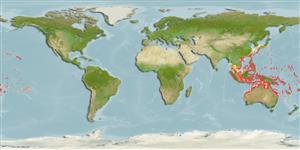Common names from other countries
>
Eupercaria/misc (Various families in series Eupercaria) >
Labridae (Wrasses) > Corinae
Etymology: Coris: Greek, kore, -es = pupil and also with themenaing of "maid" (Ref. 45335).
More on authors: Quoy & Gaimard.
Environment: milieu / climate zone / depth range / distribution range
Écologie
marin récifal; profondeur 0 - 50 m (Ref. 1602). Tropical; 37°N - 31°S, 96°E - 142°W
Pacific Ocean: Christmas and Cocos-Keeling Islands in the eastern Indian Ocean to the Society and Tuamoto islands, north to Japan and the Hawaiian Islands, south to Australia. Replaced by Coris cuvieri in the Indian Ocean (Ref. 37816).
Taille / Poids / Âge
Maturity: Lm ? range ? - ? cm
Max length : 40.0 cm TL mâle / non sexé; (Ref. 2334); common length : 20.0 cm TL mâle / non sexé; (Ref. 27550)
Épines dorsales (Total) : 9; Rayons mous dorsaux (Total) : 12 - 13; Épines anales: 3; Rayons mous anaux: 12. Juveniles easily recognized by their striking coloration. Females have a bright yellow caudal fin (Ref. 48636).
A solitary species (Ref. 90102) found in areas of mixed coral, sand and rubble of exposed outer reef flats, lagoon and seaward reefs (Ref. 1602, 48636). Benthopelagic (Ref. 58302). Feeds mainly on mollusks, crabs, and hermit crabs, and occasionally on tunicates and forams (Ref. 1602). Minimum depth reported taken from Ref. 128797.
Life cycle and mating behavior
Maturities | Reproduction | Spawnings | Egg(s) | Fecundities | Larves
Oviparous, with distinct pairing during breeding (Ref. 205).
Randall, J.E., 1999. Revision of the Indo-Pacific labrid fishes of the genus Coris, with descriptions of five new species. Indo-Pac. Fish. (29):74 p. (Ref. 33411)
Statut dans la liste rouge de l'IUCN (Ref. 130435)
CITES (Ref. 128078)
Not Evaluated
Menace pour l'homme
Reports of ciguatera poisoning (Ref. 4690)
Utilisations par l'homme
Pêcheries: commercial; Aquarium: Aquariums publics
Outils
Articles particuliers
Télécharger en XML
Sources Internet
Estimates based on models
Preferred temperature (Ref.
115969): 24.3 - 29, mean 27.9 (based on 690 cells).
Phylogenetic diversity index (Ref.
82804): PD
50 = 0.5000 [Uniqueness, from 0.5 = low to 2.0 = high].
Bayesian length-weight: a=0.00977 (0.00470 - 0.02030), b=3.07 (2.89 - 3.25), in cm Total Length, based on LWR estimates for this (Sub)family-body shape (Ref.
93245).
Niveau trophique (Ref.
69278): 3.5 ±0.2 se; based on diet studies.
Résilience (Ref.
120179): Milieu, temps minimum de doublement de population : 1,4 à 4,4 années (Preliminary K or Fecundity.).
Fishing Vulnerability (Ref.
59153): Low to moderate vulnerability (30 of 100).
